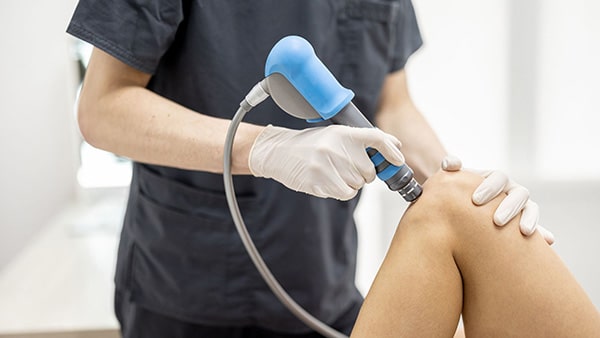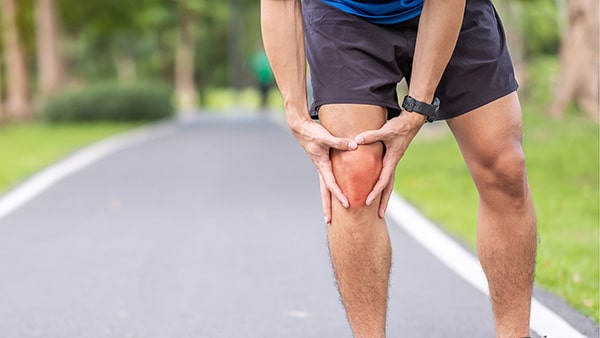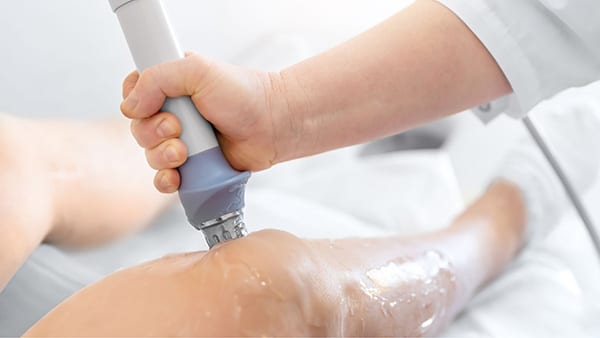La tendinite est une blessure fréquente chez les sportifs. Elle l’est notamment chez les pratiquants de musculation, car cette activité implique des contraintes importantes sur les articulations.
Avant d’envisager un traitement chirurgical, il existe heureusement d’autres options. Intéressons-nous aujourd’hui aux ondes de choc, un traitement médical utilisé pour soulager les zones inflammatoires.
Le traitement par ondes de choc, en bref :
- La tendinite est une blessure fréquente chez les sportifs.
- Les ondes de choc sont un traitement médical qui accélère la cicatrisation des tissus.
- Elles sont appliquées par un kinésithérapeute à l’aide d’un appareil spécifique.
- Deux types existent : les ondes de choc focales et radiales (les radiales sont utilisées pour les tendinites).
- Le traitement est indolore mais peut provoquer une sensation désagréable.
- Un protocole typique comprend 3 à 6 séances espacées d’une semaine.
Sommaire
Qu’est-ce qu’une onde de choc ?
Il faut remonter au début des années 1990 pour trouver trace des premières thérapies par ondes de choc. Ces dernières étaient à l’origine utilisées pour traiter les calculs rénaux, sans causer d’effets secondaires.
Les professionnels de la médecine ont rapidement remarqué que l’onde de choc permettait également d’accélérer la cicatrisation des tissus, et donc de guérir une inflammation douloureuse.
Mais concrètement, de quoi s’agit-il ?
Une onde de choc désigne simplement une répétition d’impulsions, des ondes acoustiques, délivrées sur une zone du corps ayant subi une lésion.
Aussi connue sous le nom de ShockWave Therapy (SWT), cette technique est le plus souvent appliquée par un kinésithérapeute ou un chiropracteur. Elle implique d’être équipé d’un matériel spécifique, prenant généralement la forme d’un pistolet.
L’appareil à onde de choc offre plusieurs possibilités de réglages, telles que la fréquence de percussion, la pression exercée ou encore le nombre d’impulsions. Cela permet ainsi de s’adapter à la pathologie du patient et à sa tolérance à la douleur.

On distingue 2 grands types d’ondes de choc :
- Les ondes de choc focales
- Les ondes de choc radiales
Dans le cas d’une thérapie par ondes de choc pour une tendinite (ou pour une contracture musculaire), ce sont les radiales qui sont utilisées.
Quelles pathologies peuvent être traitées par les ondes de choc ?
Les ondes de choc sont aujourd’hui largement utilisées pour soigner une tendinite (ou tendinopathie).
Imaginez le tendon comme un cordon reliant des os et des muscles. Lorsque la sollicitation de ce cordon est trop importante, une dégénérescence ou une inflammation de la structure se produit. Les causes peuvent être multiples : gestes répétés au travail, pratique trop intensive de la course à pied, manque d’échauffement lors d’une activité sportive, etc.
C’est ce phénomène douloureux que l’on appelle une tendinite.

DÉCOUVREZ TOUS MES PROGRAMMES
Téléchargez mon application MetamorphX et commencez votre transformation physique dès aujourd’hui !
Les tendinites peuvent toucher plusieurs parties du corps :
- L’épaule, au niveau de la coiffe des rotateurs
- Le coude (on parle d’épicondylite)
- La hanche (on parle de périarthrite)
- La main et le poignet
- Le genou
- L’arrière du talon, notamment le tendon d’Achille qui relie le mollet à la cheville (on parle d’épine calcanéenne)
- La voûte plantaire

En plus d’être utilisée pour soigner les tendinites, les ondes de choc sont aussi appliquées lorsqu’un patient subit une lésion musculaire (élongation, déchirure, etc.), que ce soit au niveau des membres inférieurs ou supérieurs, ou souffre de douleurs articulaires chroniques.
Les bienfaits des ondes de choc sur une tendinite
Suivre des séances de kinésithérapie par ondes de choc pour une tendinite vous apportera plusieurs avantages :
- Diminution de la douleur à court terme
- Accélération de la guérison à long terme
- Augmentation de la production de collagène
Ces bienfaits ont d’ailleurs été documentés par de nombreux essais cliniques, comme cette étude datant de 2008 qui s’est intéressée à des personnes affectées par une tendinopathie d’Achille.
Diminution de la douleur à court terme
Les patients souffrant d’une tendinite ressentent le plus souvent un soulagement instantané après avoir suivi une séance d’un traitement par ondes de choc.
Un tel résultat est le fruit d’une action sur les nerfs et d’une production accrue d’endorphine, aussi connue sous le nom explicite d’hormone du plaisir. Cet effet dure entre 24 et 48 heures.
L’onde de choc freine aussi la production de la substance P. Composé de 11 acides aminés, ce peptide appartenant à la famille des tachykinines participe à la diffusion de la douleur dans le système nerveux.
Accélération de la guérison à long terme
Sur le plus long terme (entre 4 et 6 semaines), ce procédé favorise la cicatrisation en stimulant l’activation cellulaire et la circulation sanguine.
La guérison est alors plus rapide, ce qui limite la période d’arrêt des activités sportives. De même, les ondes de choc réduisent le risque de devoir subir une intervention chirurgicale.

Augmentation de la production de collagène
Un autre bienfait des ondes de choc est qu’elles favorisent la production de collagène dans l’organisme.
En plus de reconstruire les tissus, le collagène permet de les rendre plus forts. Le risque de rechute ou de nouvelle blessure est alors réduit.
Quels sont les inconvénients ?
L’onde de choc est-elle douloureuse ?
Non, les ondes de choc ne sont pas douloureuses. Certes, la sensation n’est pas agréable, allant selon les zones traitées d’un léger picotement à des chocs un petit peu plus prononcés.
C’est l’un des seuls inconvénients des ondes de choc.
Le bruit de l’appareil peut être impressionnant, du fait des coups répétés. Mais encore une fois, cela ne provoque pas de douleur insupportable. Dès la séance terminée, la gêne occasionnée s’estompe dans la plupart des cas.
Quels sont les effets secondaires des ondes de choc ?
Il n’existe quasiment pas d’effets secondaires.
L’apparition d’une rougeur ou d’un léger hématome sur la zone est un phénomène fréquent, mais sans gravité bien sûr.
Dans de plus rares cas, un gonflement peut se manifester sur le muscle ou l’articulation touché par le traumatisme.
Appliquez simplement de la glace durant quelques minutes pour résorber l’hématome ou le gonflement.
Il arrive enfin, très exceptionnellement, que certaines personnes subissent une migraine une fois la séance terminée.
Sachez qu’en termes de contre-indications, les ondes de choc sont déconseillées en cas de grossesse, de présence d’un pacemaker ou de troubles de la coagulation.
Comment se déroule un protocole d’ondes de choc chez un kiné ?
Une séance d’ondes de choc pour une tendinite dure entre 5 et 10 minutes.
Elle commence par la localisation de la zone douloureuse. Le kiné y appose ensuite un gel qui favorise le passage des ondes vers les tissus, puis applique les ondes de choc.
En complément, le professionnel de santé vous proposera d’autres soins adaptés en fonction de votre blessure et du stade de votre rééducation : massages, renforcement musculaire, étirements légers, etc.
Prévoyez entre 3 à 6 séances pour être pleinement rétabli, avec environ 1 semaine d’intervalle entre chaque. Vous sentirez toutefois une amélioration progressive de la situation au fil des rendez-vous.
Pour les sportifs, le kinésithérapeute vous guidera dans la reprise de votre activité physique. Il vous donnera le feu vert pour reprendre pleinement votre pratique lorsqu’il jugera que vous êtes prêt.
Mon avis sur les ondes de choc
En tant qu’athlète, j’ai déjà eu recours aux ondes de choc à plusieurs reprises pour apaiser des douleurs musculaires et articulaires, comme vous pouvez le voir dans la vidéo ci-dessous. De mon expérience personnelle, il s’agit d’un traitement efficace qui a largement fait ses preuves ces dernières années. Et si vous êtes concerné, je vous invite aussi à consulter cet article qui détaille comment soigner une tendinite.
FAQ
Oui, elles soulagent rapidement la douleur et accélèrent la guérison en stimulant la régénération des tissus.
Non, il peut être inconfortable mais reste supportable. La sensation varie selon la zone traitée.
En général, 3 à 6 séances espacées d’une semaine suffisent pour obtenir des résultats significatifs.
Ils sont rares et légers : rougeurs, petits hématomes ou gonflements temporaires.
Un kinésithérapeute ou un chiropracteur équipé d’un appareil spécifique.
Oui, elles sont déconseillées en cas de grossesse, de pacemaker ou de troubles de la coagulation.





